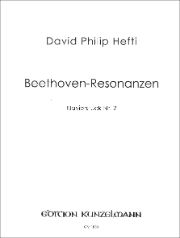Beethoven foreshadowing
A sophisticated piano composition with a "double bottom".

David Philip Hefti wrote his Beethoven resonanceshis second piano piece, commissioned by the Musikkollegium Winterthur. The task was to write a solo piano work with reference to Beethoven's symphonies. Hefti took the theme from the slow movement of the 7th Symphony as the starting point for his piece.
"The compositional means in this piano piece were reduced to the extent that the extended playing techniques inside the grand piano ... were dispensed with. By using all three pedals and various pedal effects, a multi-layered palette of timbres is nevertheless achieved. In addition, a field of tension is created between free and precisely notated passages as well as between sharp attacks and delicately resonating echo tones, which again and again give a hint of Beethoven's music in diffuse sound form." This precise and very accurate description comes from the composer himself. In fact, the Beethoven quotations are only superficially perceptible in a few places. Much more dominant are the resonances, which give the piece a "double bottom" with the help of the frequently used sustaining pedal.
The result is a sophisticated composition that can also exist independently of Beethoven's subject matter, as a Piano Piece No. 2. And although only traditional playing techniques are used and the musical text reads clearly and plausibly, the work requires - as the writer was able to see for himself - a good deal of patience and discipline when rehearsing ...
David Philip Hefti: Beethoven Resonances, Piano Piece No. 2, GM 1880, Fr. 21.00, Edition Kunzelmann, Adliswil 2012








